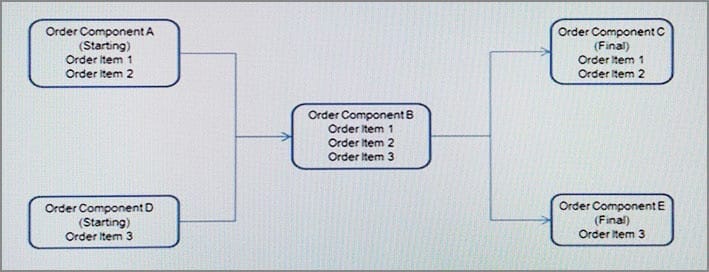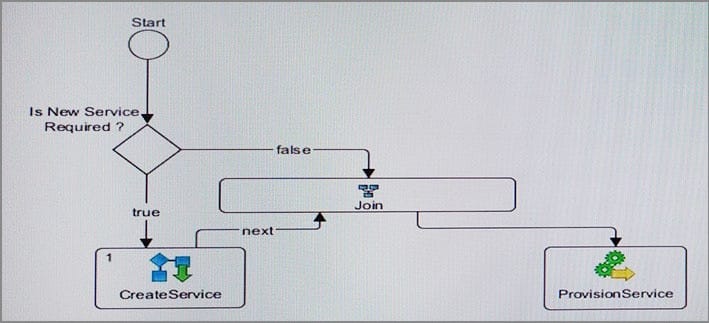1Z0-493 Online Practice Questions and Answers
This diagram represents the orchestration plan of an order that you submitted on January 1. The following are configured in your cartridge:
-
Each order component has a minimum processing duration of two days.
-
The product specification of Order Item 3 has a minimum processing duration of four days.
-
In the product specification of Order Item 3, Order Component B has a duration of four days.
Considering that the requested delivery date is set to January 10 for all order items, when will the order start its execution?

A. January 1
B. January 2
C. January 4
D. January 6
E. January 8
F. January 10
What kind of fallout scenario might occur during communication between OSM and a downstream system that should eventually be resolved by simply retrying the communication?
A. invalid message request sent to the downstream system
B. network connectivity error
C. failure due to slow downstream system processing
D. internal downstream system application error
E. unsupported business process requests
You detect some performance issues during the execution of a load test in an environment that will be used to fulfill a large number of orders in a given day. Which three resources should you check and reconfigure in your Oracle WebLogic Server console in order to provide better performance to this environment?
A. database connections
B. threads
C. users and groups
D. JMS queues
E. deployments
A requirement indicates that OSM should send a message to an upstream system when a manual task in your provisioning process reaches the Received state. How would you model this functionality in your cartridge?
A. with Data Change Notifications implemented at the Order level
B. with Data Change Notifications implemented at the Task level
C. with Milestone Event Notifications implemented at the Order level
D. with Task-State Event Notifications implemented at the Task level
E. with Jeopardy Notifications implemented at the Order level
F. with Jeopardy Notifications implemented at the Task level
Which OSM component should not be installed on Linux environments?
A. Database Schema
B. Database Utilities
C. Server
D. Administrator
E. SDK Tools
F. SDK Samples
You have configured the following process flow in your OSM. Identify two possible outcomes of this process.

A. When the Join Type configuration of the Join element is set to ALL, the ProvisionService task will never be executed.
B. The Join Type configuration of the Join element must be set to ALL for the process to execute correctly.
C. The Join element can be eliminated from the process and the same logic can be implemented with the remaining elements.
D. The "Is New Service Required?" element can have as many exit flows as needed, if the use case logic requires it.
E. There would be an error if the "Next" transition is substituted by a transition without status.
You have a cartridge that defines three stages of decomposition. The first stage contains order components that represent functions, the second stage contains order components that represent target systems, and the third stage contains order components that represent granularities. You want to define decomposition rules that always apply the same granularity to a function, independent of the target system that this function is communicating to. How would you design these decomposition rules such that it is easy to maintain them in the future evolutions of your system topology?
A. a single decomposition rule with the function as the source order component and the granularity as the target order component
B. a single decomposition rule that has all target systems as source order components and the granularity as the target order component
C. a single decomposition rule that has only the target systems used by the function as source order components and the granularity as the target order component
D. one decomposition rule for each target system, having this target system as the source order component and the granularity as the target order component
E. one decomposition rule for each target system used by the function, having this target system as the source order component and the granularity as the target order component
You are working with an architecture that involves multiple billing systems. Each billing system returns its own set of external fulfillment states that you want to map to a smaller set of mapped fulfillment states defined in your cartridge. Identify two ways to implement this.
A. Preprocess the external fulfillment states in the automation that communicates to each billing system and define a single Fulfillment State Map for all billing systems.
B. Push the external fulfillment states unaltered in the automation that communicates to the billing system and define a Fulfillment State Map for each billing systems.
C. Push the external fulfillment states unaltered in the automation that communicates to the billing system and define an Order Item Composition Rule Set for each billing systems.
D. Push the external fulfillment states unaltered in the automation that communicates to the billing system and define an Order Composition Rule Set for each billing systems.
E. Push the external fulfillment states unaltered in the automation that communicates to the billing system and define an upstream system notification logic for each billing systems.
You implement an expression condition XQuery in a decomposition rule. You want to execute unit tests with your own order samples in a development environment before publishing this code. Which three statements are true about possible approaches to confirm the validity of your code?
A. Use a third-party XQuery editor to verify the functional correctness of the code.
B. Insert in your code a call to an OSM productized XQuery function, which writes log messages on server log files.
C. Verify the decomposition by using the Decomposition tree in the Order Management Web client.
D. Verify dependencies by using the Dependency Graph in the Order Management Web client.
E. Submit multiple copies of the same order concurrently to verify the functional correctness of the code.
Why would you use the following XPath expression while defining a behavior for a task?

A. to apply a condition to the behavior
B. to access data from a database
C. to include complex logic in the behavior
D. to get a list of values from the task data
E. to launch a parallel automated task

